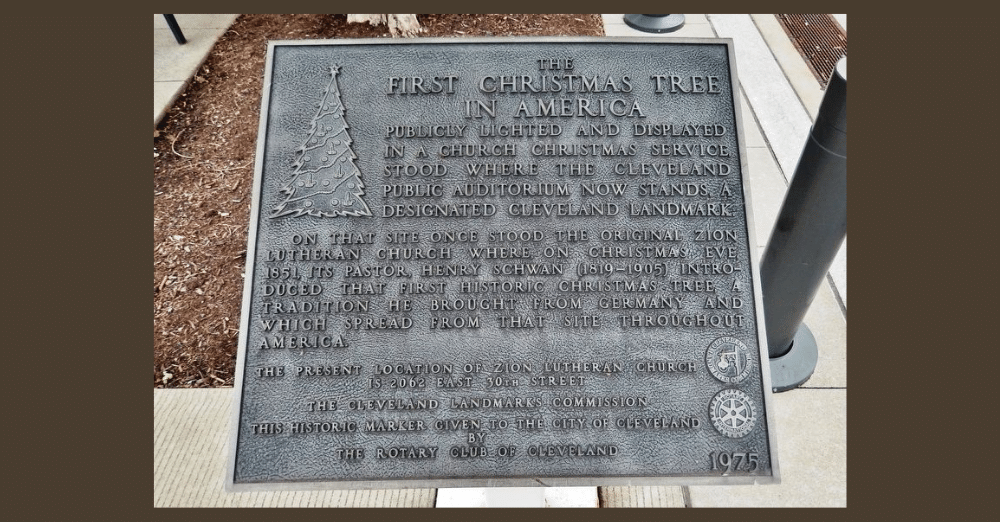


The First Christmas Tree in America publicly lighted and displayed in a church Christmas service stood where the Cleveland Public Auditorium now stands, a designated Cleveland Landmark.
On that site once stood the original Zion Lutheran Church where on Christmas Eve, 1851, its pastor, Henry Schwan (1819-1905) introduced that first historic Christmas tree, a tradition he brought from Germany and which spread from that site throughout America.
The present location of Zion Lutheran Church
is 2062 East 30th Street
The Cleveland Landmark Commission
This historic marker given to the City of Cleveland
by
The Rotary Club of Cleveland
1975
41° 30.175′ N, 81° 41.678′ W. Marker is in Cleveland, Ohio, in Cuyahoga County. Marker is on West Mall Drive south of Lakeside Avenue East, on the left when traveling south. Marker is located along the sidewalk, overlooking the Cleveland Mall.
Most 19th-century Americans found Christmas trees an oddity. The first record of one being on display was in the 1830s by the German settlers of Pennsylvania, although trees had been a tradition in many German homes much earlier. The Pennsylvania German settlements had community trees as early as 1747, but, as late as the 1840s Christmas trees were seen as pagan symbols and not accepted by most Americans.
It is not surprising that, like many other festive Christmas customs, the tree was adopted so late in America. To the New England Puritans, Christmas was sacred. The pilgrims' second governor, William Bradford, wrote that he tried hard to stamp out “pagan mockery†of the observance, penalizing any frivolity. The influential Oliver Cromwell preached against “the heathen traditions†of Christmas carols, decorated trees, and any joyful expression that desecrated “that sacred event.†In 1659, the General Court of Massachusetts enacted a law making any observance of December 25 (other than a church service) a penal offense; people were fined for hanging decorations. That stern solemnity continued until the 19th century, when the influx of German and Irish immigrants undermined the Puritan legacy.
Pastor Heinrich (Henry) Christian Schwan made history when he celebrated his first Christmas in Cleveland by placing a candlelit tree in his church’s sanctuary, a custom that was popular in Germany, his native country, and helped spread the tradition across America.
Early on Christmas Eve 1851, the Rev. Schwan, newly installed pastor of Zion Lutheran Church in Cleveland, went into the forest near his parsonage and chopped down a small beautifully-shaped evergreen. After taking it into his church and placing it in a prominent spot in the chancel, he and his wife, Emma, spent the afternoon trimming the tree with cookies, colored ribbons, fancy nuts and candles. A silver star that Schwan had brought with him from his boyhood home in Hanover, Germany, topping off the tree, was a reminder of his happy boyhood Christmases.
The custom hadn't caught on yet in America. He wanted to share this same happiness with members of his congregation, most of whom were also German-born and thus likely to have seen a Christmas tree in their past.
Most of the members of his congregation were pleasantly surprised, and wonderful Christmas memories of the Old Country were enkindled by the sight of the beautifully decorated and lighted tree. Others, however, were offended by the idea of having a Tannenbaum in church.